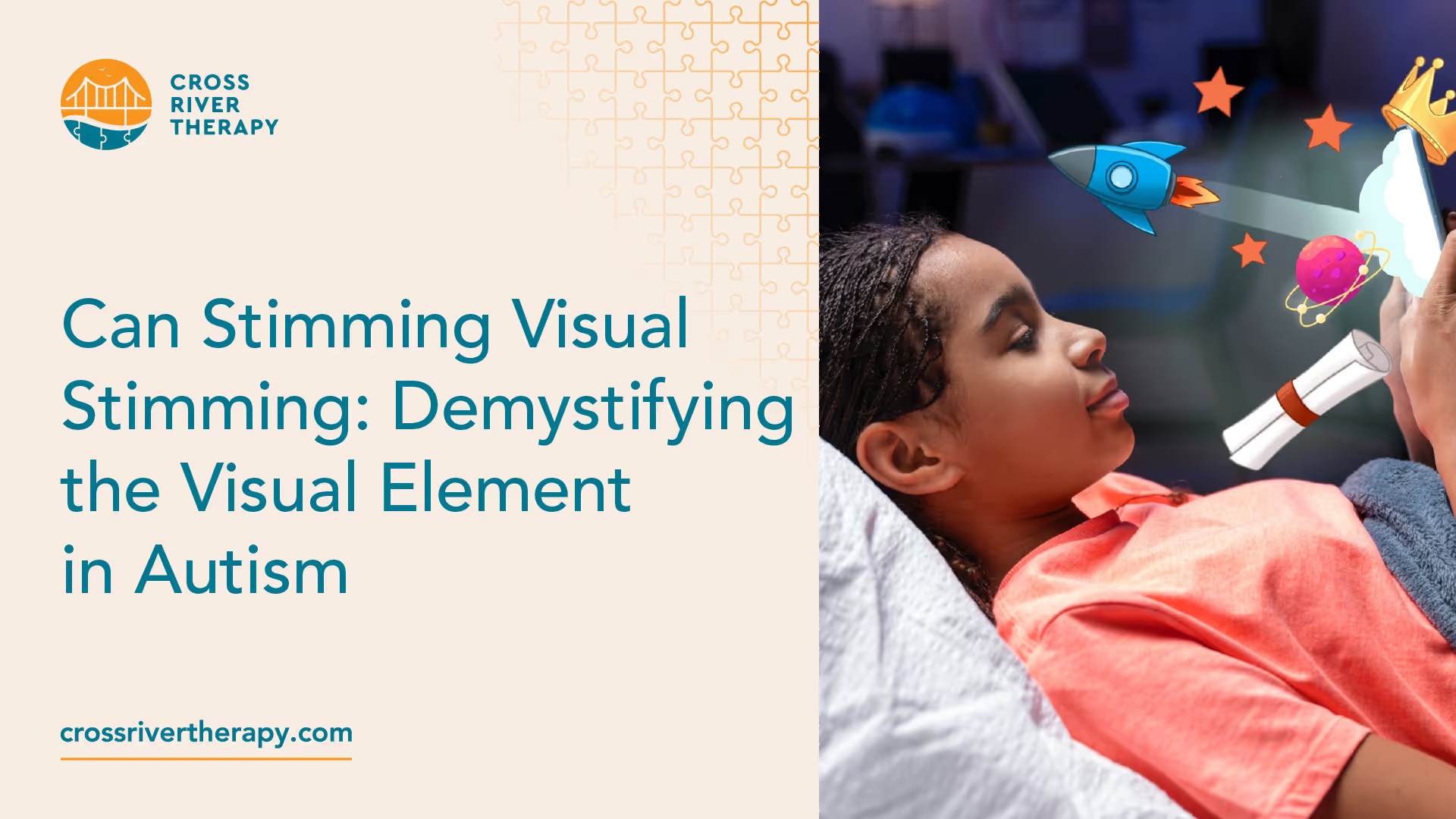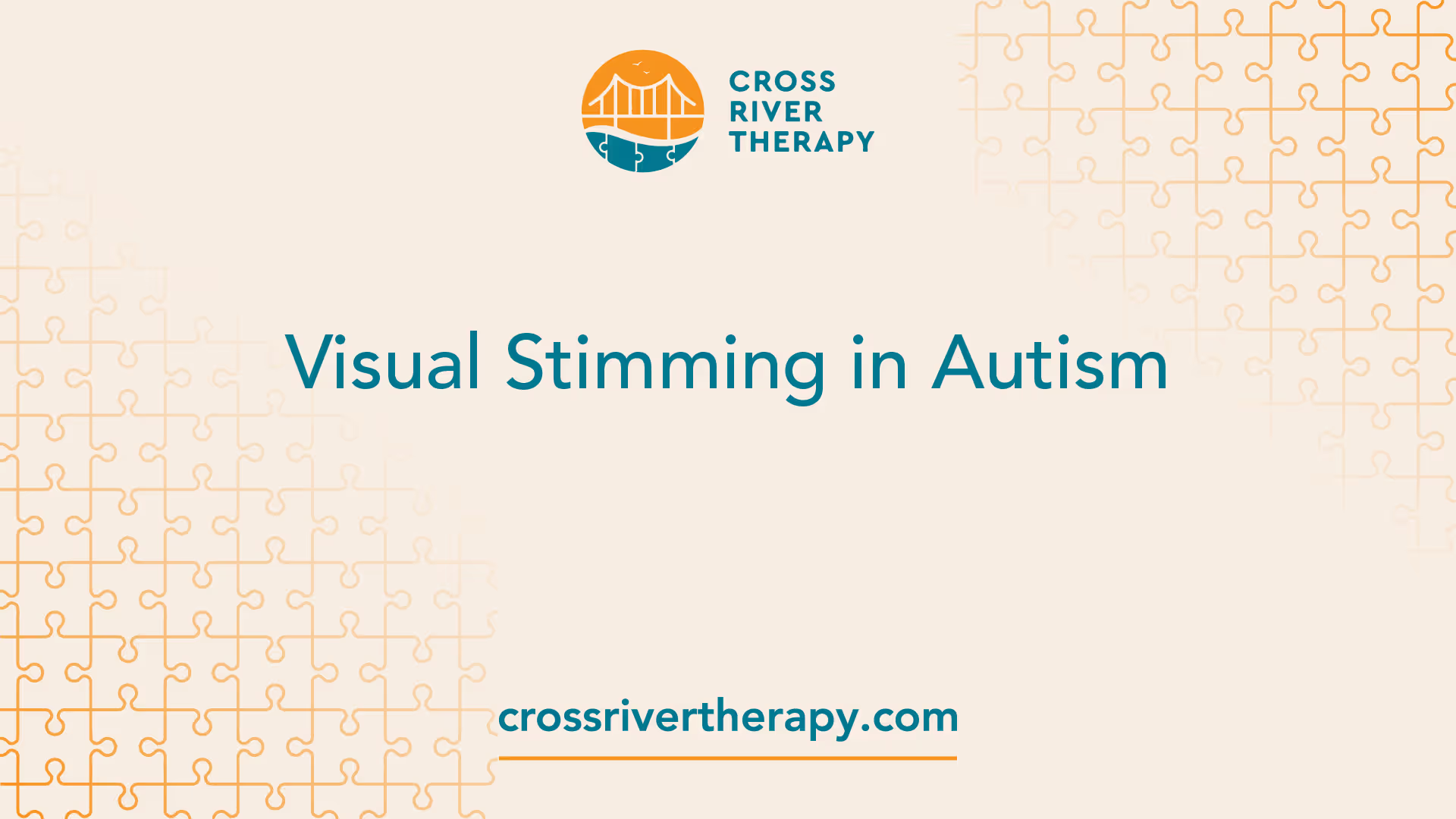Can Stimming Visual Stimming: Demystifying the Visual Element in Autism
"Can stimming be visual?" Dive into the world of visual stimming in autism, its benefits, and management.
Understanding Visual Stimming
The world of autism is rich with unique behaviors and experiences, one of which is stimming. As we delve into this topic, we'll explore if stimming can be visual, what characterizes it, and its function for individuals with autism.

Definition and Characteristics
Stimming, clinically referred to as 'self-stimulatory behaviors,' is identified by its repetitive movements and/or vocalizations. It is often associated with autism spectrum disorder (ASD) and other neurodevelopmental conditions. Stimming can manifest as a wide variety of repetitive behaviors—including physical movements and/or audible sounds—some of which are more noticeable than others. Certain stimming behaviors are most often associated with autism, while others can occur in neurodivergent and neurotypical individuals alike.
In the context of visual stimming, behaviors involve sight, such as looking at lights for a long time or frequently blinking or rolling your eyes. Other visual stimming behaviors in children with autism may include staring at objects, moving fingers in front of the eyes, hand-flapping, eye tracking, and peering from the corners of the eyes. For more examples, please refer to our article on visual stimming examples.
Purpose and Function
Stimming serves a purpose for individuals, even if they cannot verbalize the reason behind it. It can help regulate emotions and may be triggered by environmental factors such as noise, the presence of many people, or engaging in a new or difficult task [1].
Moreover, stimming behaviors in children with autism may serve various purposes such as stimulating the senses, adapting to unfamiliar environments, reducing anxiety, expressing frustration, avoiding certain activities, or coping with sensory overload.
Stimming also serves a purpose by providing an outlet for energy and helping individuals feel grounded in the moment and regulate their feelings. It allows individuals with autism to continue functioning within their environment [3]. Stimming can be beneficial for self-regulation and mental health, as it helps individuals process their emotions and improve their mental well-being.
In conclusion, understanding visual stimming—the what, why, and how—can provide invaluable insights into the unique experiences of individuals with autism. It can help caregivers, educators, and therapists create more supportive and inclusive environments for these individuals. For more information on this topic, visit our article on can you stim and not have autism?.
Visual Stimming in Autism
Stimming, or self-stimulatory behavior, is a common characteristic of Autism Spectrum Disorder (ASD). One form of stimming is visual stimming, which involves behaviors related to sight.

Prevalence and Observations
Visual stimming behaviors are prevalent among individuals with autism. It's a common way for them to cope with sensory overload, anxiety, or frustration. These behaviors involve sight, such as looking at lights for a long time or frequently blinking or rolling your eyes. Other examples include staring at objects, repetitive blinking, moving fingers in front of the eyes, hand-flapping, eye tracking, peering from the corners of the eyes, and object placement like lining up objects [4].
It's important to note that individuals with autism may experience senses differently, with heightened senses leading to a more intense experience of the world. This could, in part, explain why visual stimming behaviors are more pronounced in those with autism. To learn more about this, you can read our article on can you stim and not have autism?.
Triggers and Sensory Overload
Visual stimming can be triggered by sensory overload, such as heightened sensitivities to sensory stimuli like lights, sounds, or textures. Anxiety and frustration can also lead to visual stimming behaviors. Individuals on the autism spectrum or those with sensory processing disorders may engage in visual stimming as a coping mechanism to regulate emotions and manage sensory input.
Children who are under-responsive to visual input may seek out increased visual stimulation to alert the brain, while those who are over-responsive may process lighting as much brighter and feel overwhelmed by varying visual stimulation in the room [4].
Understanding the triggers and sensory overload that can lead to visual stimming is crucial for managing these behaviors and supporting individuals with autism. Familiarizing oneself with various visual stimming examples can help caregivers identify and address these behaviors in a supportive and constructive manner.
Benefits of Visual Stimming
Visual stimming, often observed in individuals with autism, serves multiple purposes and offers several benefits. Let's delve into how visual stimming aids in self-regulation, coping, communication, and expression.

Self-Regulation and Coping
Visual stimming serves a significant role in self-regulation and coping mechanisms for individuals with autism. This behavior provides an outlet for energy and helps individuals feel grounded in the moment, allowing them to better regulate their feelings.
These repetitive behaviors may be triggered by environmental factors such as noise, the presence of many people, or engaging in a new or difficult task [1]. By engaging in visual stimming, the individual can continue functioning within their environment, managing their emotional balance and mental well-being.
Stimming actions are also thought to help with sensory overload, reducing anxiety and relieving physical discomfort. For more examples of visual stimming behaviors and the benefits they provide, please visit our article about visual stimming examples.
Communication and Expression
While stimming behaviors, including visual stimming, may not always be clear to others, they often serve as forms of communication and expression for individuals with autism. Even if the individual cannot verbalize the reason behind their stimming behavior, these actions can indicate their emotional state, such as being overwhelmed, excited, anxious, or happy.
Understanding these behaviors can help parents and caregivers better support their loved ones with autism. With the help of behavior specialists or therapists with autism experience, family members and caregivers can gain insights into the reasons for the behavior.
Remember, stimming is not exclusive to those with neurodevelopmental disorders. The question can you stim and not have autism? explores this topic further.
In conclusion, visual stimming behaviors provide valuable benefits for individuals with autism, aiding in self-regulation, coping, communication, and expression. By understanding these benefits, we can better support and accommodate individuals who engage in these behaviors.
Managing Visual Stimming
While visual stimming can serve a functional purpose for individuals with autism, it may sometimes be necessary to manage these behaviors, especially when they interfere with daily life or pose safety concerns. To do this, one can employ supportive strategies and therapeutic interventions.
Supportive Strategies
Supportive strategies aim at creating a safer and more acceptable environment for stimming behaviors. It's important to understand that stimming serves a purpose for individuals, even if they cannot verbalize the reason behind it. It helps regulate emotions and may be triggered by environmental factors such as noise, the presence of many people, or engaging in a new or difficult task.
Rather than trying to stop stimming behaviors completely, consider incorporating tools like fidget spinners, stress balls, and fidget toys. These can help fulfill the need to stim in a more socially acceptable manner [5].
For instance, if your child engages in visual stimming examples such as staring at lights or spinning objects, using a fidget spinner can provide a similar visual experience in a safer way. It's suggested that society, rather than autistic individuals, may need to adapt to accommodate these behaviors.
Therapeutic Interventions
In addition to supportive strategies, therapeutic interventions can also be beneficial in managing visual stimming behaviors. While these strategies should be personalized and guided by a professional, they often involve teaching replacement behaviors or coping strategies.
For example, if a child is visually stimming by flickering lights on and off, they could be taught to use a flashlight or a light-up toy instead. This provides a similar visual stimulus in a more controlled and less disruptive manner.
Therapeutic interventions can also involve the use of tactile stimming strategies. The sense of touch can be powerful, and different textures can evoke very different reactions in those with sensory processing disorders. Vibrating sensory cushions, for instance, can help meet that need or redirect tactile stims.
Remember, the goal of managing visual stimming is not to eliminate these behaviors entirely, but to ensure they're safe and socially acceptable. It's important to respect and honor the individual's need to stim while also considering their overall well-being and comfort. To learn more about stimming in general, you may want to read our article can you stim and not have autism?.
Types of Visual Stimming Behaviors
Visual stimming, a common behavior in individuals with autism, involves engaging in repetitive visual activities as a form of self-expression, communication, and coping mechanism [4].
Examples and Variations
Visual stimming behaviors can vary widely depending on the individual. Some common examples include staring at objects, repetitive blinking, moving fingers in front of the eyes, hand-flapping, eye tracking, peering from the corners of the eyes, and arranging objects in a line.
Other visual stims might include staring at moving objects like ceiling fans or screensavers, turning lights on and off, or watching the colors change on sensory lighting. The mesmerizing effect of the changing colors can be particularly soothing for those who experience visual stimming.
For a more comprehensive list of visual stimming behaviors, check out our article on visual stimming examples.
Impact on Daily Life
Visual stimming is commonly observed in individuals with autism and can occur in response to a range of emotions, including excitement, happiness, boredom, stress, fear, and anxiety.
While visual stimming can serve as a coping mechanism for dealing with sensory experiences that may be intense or aversive, it can also impact daily life in various ways. At times, these behaviors might interfere with learning, social interactions, or other activities. On the other hand, they can also enable individuals to convey their emotions, needs, or reactions to their surroundings [8].
It's important to note that stimming behaviors, including visual stimming, are not exclusive to autism. They can also be observed in individuals with ADHD, sensory processing disorders, and others. To learn more about this, visit our article: can you stim and not have autism?.
Understanding these behaviors and their impact is crucial for providing appropriate support and creating inclusive environments for individuals who engage in visual stimming.
Supporting Individuals with Visual Stimming
To answer the question, 'can stimming be visual?', it is essential to understand that visual stimming is a common behavior seen in individuals with autism. It serves as a self-regulatory mechanism and can be a vital tool for emotional regulation. Supporting individuals who engage in visual stimming involves understanding their needs, providing guidance to caregivers, and fostering inclusive environments.
Caregiver Guidance
Stimming behaviors, such as visual stimming, serve a purpose for individuals, even if they cannot verbalize the reason behind it. It can help regulate emotions and may be triggered by environmental factors such as noise, the presence of many people, or engaging in a new or difficult task. Thus, caregivers need to understand the underlying reasons behind these behaviors to provide effective support.
In a study published in the journal Autism, individuals with autism described stimming as a mechanism that helps them soothe or communicate intense emotions or thoughts. They argued that these behaviors may serve as useful coping mechanisms and objected to treatments aimed at eliminating the behaviors.
While it may not be possible or appropriate to stop stimming behaviors, strategies such as using fidget spinners, stress balls, and fidget toys can help create safer and more acceptable stimming behaviors. It is crucial for caregivers to understand that society, rather than autistic individuals, may need to change to accommodate these behaviors. For more information on specific visual stimming behaviors, refer to our article on visual stimming examples.
Creating Inclusive Environments
Creating inclusive environments for individuals who engage in visual stimming involves recognizing sensory overload triggers and addressing anxiety and frustration factors. By doing so, caregivers, educators, and professionals can implement effective strategies for managing visual stimming behaviors.
In recent years, the narrative around stimming has shifted to focus more on acceptance and understanding rather than trying to control or treat stimming behaviors. Stimming is now recognized as a form of adaptive behavior that can serve as a tool for emotional regulation [1].
The key to creating inclusive environments lies in fostering understanding and acceptance of stimming behaviors, including visual stimming. By doing so, we can ensure that individuals who engage in visual stimming feel accepted and empowered to express themselves.
Remember, stimming is not exclusive to individuals with autism. If you're wondering, can you stim and not have autism?, the answer is yes. Understanding this can further help in creating a more inclusive and accepting environment.
References
[1]: https://health.clevelandclinic.org/what-is-stimming/
[2]: https://www.psychologytoday.com/us/basics/stimming
[3]: https://www.webmd.com/brain/autism/what-you-need-to-know-about-stimming-and-autism
[4]: https://www.healisautism.com/post/visual-stimming-what-can-we-do-about-it
[5]: https://www.psychiatry.org/news-room/apa-blogs/understand-stimming-repetitive-behaviors-purpose
[6]: https://www.betterhelp.com/advice/behavior/25-examples-of-stimming-behaviors/
[7]: https://www.experia-usa.com/blog/understanding-different-types-stimming/



